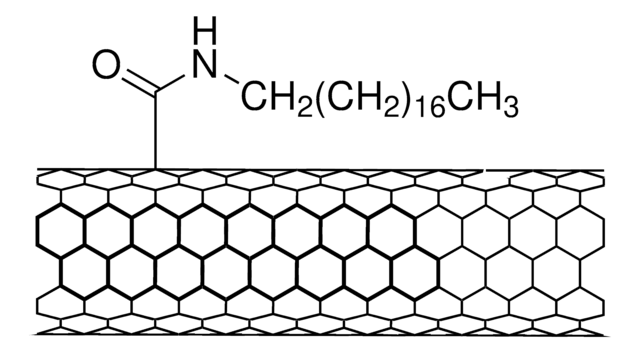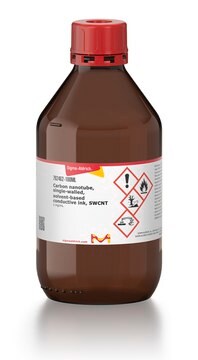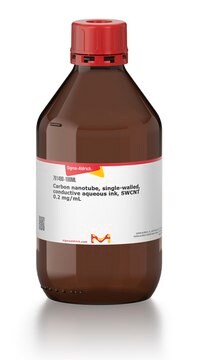Kluczowe dokumenty
639230
Carbon nanotube, single-walled
polyaminobenzene sulfonic acid functionalized, 75-85%carbon basis, D × L 1.1 nm × 0.5-1.0 μm , bundle dimensions
Synonim(y):
Carbon nanotube, single-walled, PABS functionalized, SWNT, PABS functionalized
About This Item
Polecane produkty
product name
Carbon nanotube, single-walled, polyaminobenzene sulfonic acid functionalized, 75-85% carbon basis, D × L 1.1 nm × 0.5-1.0 μm , bundle dimensions, avg. no. of layers, 1
Poziom jakości
Próba
75-85% carbon basis
Postać
powder
masa cząsteczkowa
average Mw 400-600 g/mol (PABS)
Właściwości
avg. no. of layers 1
zakres etykietowania
65% (PABS, typical)
śr. × dł.
1.1 nm × 0.5-1.0 μm , bundle dimensions
zanieczyszczenia
4% metals
rozpuszczalność
ethanol: 0.05 mg/mL
DMF: 0.1 mg/mL
H2O: 5.0 mg/mL (As determined by near-IR absorbance spectroscopy.)
grupa funkcyjna
sulfonic acid
Powiązane kategorie
Opis ogólny
Zastosowanie
Opakowanie
Uwaga dotycząca przygotowania
Komentarz do analizy
Hasło ostrzegawcze
Warning
Zwroty wskazujące rodzaj zagrożenia
Zwroty wskazujące środki ostrożności
Klasyfikacja zagrożeń
Eye Irrit. 2 - STOT SE 3
Organy docelowe
Respiratory system
Kod klasy składowania
11 - Combustible Solids
Klasa zagrożenia wodnego (WGK)
WGK 3
Temperatura zapłonu (°F)
Not applicable
Temperatura zapłonu (°C)
Not applicable
Środki ochrony indywidualnej
dust mask type N95 (US), Eyeshields, Gloves
Wybierz jedną z najnowszych wersji:
Masz już ten produkt?
Dokumenty związane z niedawno zakupionymi produktami zostały zamieszczone w Bibliotece dokumentów.
Klienci oglądali również te produkty
Produkty
Carbon nanotubes are materials that possess remarkable properties and offer extraordinary possibilities.
Nanorurki węglowe (CNT) cieszą się dużym zainteresowaniem od czasu ich odkrycia w 1991 roku przez Sumio Lijima1 ze względu na ich doskonałe właściwości mechaniczne, elektryczne i optyczne.
Carbon nanotubes (CNTs) have received much attention since their discovery in 1991 by Sumio lijima1 due to their excellent mechanical, electrical, and optical properties.
A nanocomposite is typically defined as a mixture between a host material (e.g., polymer matrix) and nanofillers with at least one dimension of less than 100 nm.
Nasz zespół naukowców ma doświadczenie we wszystkich obszarach badań, w tym w naukach przyrodniczych, materiałoznawstwie, syntezie chemicznej, chromatografii, analityce i wielu innych dziedzinach.
Skontaktuj się z zespołem ds. pomocy technicznej









